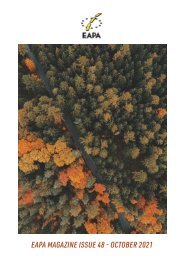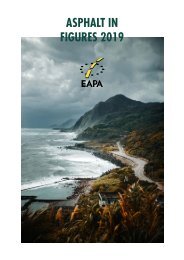EAPA Magazine 47
Dear EAPA members, dear Asphalt friends, Welcome to the 47th issue of the EAPA Magazine, our first Magazine in a new interactive form. Enjoy browsing through the pages! In this Magazine, we will inform you about the virtual E&E Congress, the work of EAPA's Committees, European Standardisation, news from Brussels, and much more. Stay safe and enjoy reading this online Magazine.
Dear EAPA members, dear Asphalt friends,
Welcome to the 47th issue of the EAPA Magazine, our first Magazine in a new interactive form. Enjoy browsing through the pages!
In this Magazine, we will inform you about the virtual E&E Congress, the work of EAPA's Committees, European Standardisation, news from Brussels, and much more.
Stay safe and enjoy reading this online Magazine.
- No tags were found...
You also want an ePaper? Increase the reach of your titles
YUMPU automatically turns print PDFs into web optimized ePapers that Google loves.
<strong>EAPA</strong> MAGAZINE ISSUE <strong>47</strong> - MAY 2021 <strong>EAPA</strong> MAGAZINE ISSUE <strong>47</strong> - MAY 2021<br />
CEN TC 227 WG1 ROAD MATERIALS –<br />
BITUMINOUS MIXTURES<br />
The latest meeting of CEN TC227 WG1 was held on<br />
11-12 May 2021.<br />
During this meeting, the latest developments in<br />
the ongoing revision of the Construction Products<br />
Regulation (CPR) were discussed and the position<br />
of the National Mirror Committees in this regard<br />
was also exchanged.<br />
The working group also dedicated extensive time<br />
to discuss the options related to the non-cited<br />
asphalt product standards. With a minority of<br />
countries in favour of de-harmonising standards<br />
and after the unsuccessful strategy of awaiting<br />
a Delegated Act from the EU Commission, which<br />
would allow modifications in the original Answer<br />
to Mandate M/124, the two options, which at the<br />
moment gained more importance, are:<br />
1. Continue with the current situation, which<br />
involves possible revisions of the non-cited<br />
standards every 5 years, while CE-Marking is<br />
done against the versions from 2006.<br />
2. In addition to Option 1, start also working on<br />
possible inputs for a potential Standardisation<br />
Request, which in the future would allow the<br />
updating of the CE-Marking versions.<br />
At the moment, there is a huge uncertainty about<br />
how long will take for the Acquis revision process<br />
to reach the 12th position in the priority list<br />
and whether CEN TCs will be actually allowed/requested<br />
to submit any inputs. For these reasons,<br />
the Group has not achieved yet a decision on how<br />
to proceed.<br />
Regarding Test Method Standards, the projects<br />
that are currently active are:<br />
Draft Standards recently approved:<br />
• EN12697-42: Amount of foreign matters in reclaimed<br />
asphalt.<br />
Draft Standards under 5-years Systematic Review:<br />
• EN 12697-4: Bitumen recovery: Fractionating<br />
column (new Work Item request and drafts for<br />
CEN Enquiry approved).<br />
• EN12697-43: Resistance to fuel. Amendments<br />
on draft for CEN Enquiry approved. CEN<br />
Enquiry expected in June 2021.<br />
• EN12697-<strong>47</strong>: - Ash content of natural asphalts<br />
(new Work Item request and drafts for CEN<br />
Enquiry approved).<br />
Draft Standards sent out for CEN-Enquiry:<br />
• EN12697-7: Determination of Bulk Density of<br />
bituminous by gamma rays (comments received<br />
and new draft approved to be sent out<br />
for Formal Vote).<br />
• EN12697-15: Determination of the segregation<br />
sensitivity (comments received and new draft<br />
approved to be sent out for Formal Vote).<br />
• EN12697-36: Determination of the thickness of<br />
a bituminous pavement sensitivity (comments<br />
received and new draft approved to be sent out<br />
for Formal Vote).<br />
• EN12697-37: Hot sand test for the adhesivity of<br />
binder on Precoated Chippings for HRA (comments<br />
received and new draft approved to be<br />
sent out for Formal Vote).<br />
• EN12697-38: Test Equipment and Calibration<br />
(comments received and under discussion<br />
whether to continue the revision, stop the work<br />
or even delete).<br />
• EN12697-41: Resistance to de-icing fluids<br />
(comments received and WG1 working on the<br />
new draft).<br />
• EN12697-49 - Friction after polishing (comments<br />
received and new draft approved to be<br />
sent out for Formal Vote).<br />
• EN12697-48: Interlayer bonding (after different<br />
delays, the draft will be issued soon for<br />
Formal Vote).<br />
Other active projects:<br />
• EN 12697-22:2020 - Wheel tracking (currently<br />
under discussion on how to proceed with possible<br />
Amendment).<br />
• EN12697-25:2016/prA1:2020 - Cyclic compression<br />
test. At the moment is being investigated<br />
whether Teflon sheets may produce<br />
results bias and affect the reproducibility of<br />
Method B.<br />
• EN 12697-26:2018 - Stiffness (decided to request<br />
a New Work Item for the Amendment of<br />
the Standard).<br />
• EN 12697-33:2019 - Specimen prepared by<br />
roller compactor (decided to request a New<br />
Work Item for the Amendment of the Standard).<br />
Next meeting will be held online on 26-27 October<br />
2021.<br />
CEN TC 227 WG6 ROAD MATERIALS -<br />
SUSTAINABILITY<br />
CEN TC227 WG6 had the last meeting on 13 April<br />
2021.<br />
The main topic of the meeting was the drafting<br />
of the Product Category Rules (PCR) for the<br />
Environmental Product Declarations (EPD) of bituminous<br />
mixtures, which is under the umbrella of<br />
the Core Rules for the EPD of construction products,<br />
Standard EN 15804+A2.<br />
The first draft had the form of an EN Standard and<br />
was sent out for CEN Enquiry in March 2020 but<br />
Member States rejected it, attaching more than<br />
60 pages of comments advising in very different<br />
directions.<br />
This put CEN TC227 WG6 in a very complex situation<br />
to reach a solution that satisfies all Member States<br />
and remains in compliance with EN 15804+A2.<br />
After long discussions, the Group decided to let the<br />
current Work Item lapse and restart the project as<br />
a European Technical Specification (TS), instead of<br />
EN Standard.<br />
The new TS will establish a guidance for product<br />
category rules complementary to EN 15804, focusing<br />
only on the case of cradle to gate with options<br />
(modules A1-A5, C1-C4 and D) and for the<br />
declared unit “tonne of bituminous mixture”.<br />
The elaboration of this draft is currently in process<br />
and in the lats meeting different aspects of this<br />
were discussed.<br />
CEN TC336 BITUMINOUS BINDERS<br />
The latest plenary meeting of TC336 was held online<br />
on 18 November 2020 with the participation of<br />
the European Commission Consultant Jean Carlo<br />
Benotti, who kindly answered all the questions<br />
raised by the participants.<br />
The main discussions covered the non-citation of<br />
5 Standards, which similarly to the case described<br />
for CEN TC227, were approved by CEN but rejected<br />
by the European Commission. In some cases, e.g.<br />
EN 12591 “Paving grade bitumen”, there is still a<br />
previous version from 2013 cited in the OJEU that<br />
can be used for CE-Marking purposes. However,<br />
in other cases, such as EN 13924-1 “Hard paving<br />
grade bitumen”, or EN13924-2 “Multigrade paving<br />
grade bitumen”, there is not any previous version.<br />
Consequently, the CE-Marking is not possible.<br />
Unlike asphalt mixtures, bitumen is a material<br />
with great international market across borders.<br />
Hence, the lack of updated Product Standards for<br />
the correct implementation of CE-Marking has<br />
put the sector is in a very complicated situation.<br />
Consequently, CEN TC336 decided to work on a<br />
Standardisation Request, with the aim of, after its<br />
approval, producing the consequent Harmonise<br />
Standards. After a long drafting process, the draft<br />
was finally submitted to the European Commission.<br />
Due to the big amount of work, the European<br />
Commission created the so-called CPR Aquis<br />
system, where a priority racking to handle<br />
Standardisation Requests was stablished around<br />
26 27








